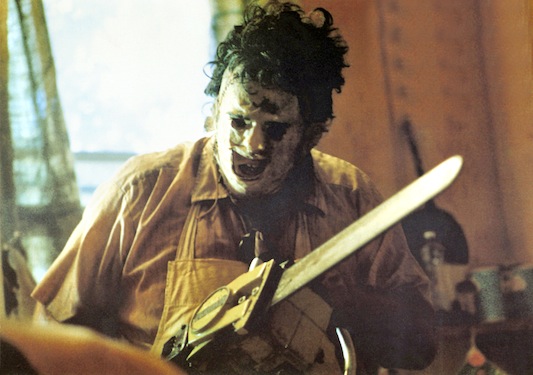Jim’s Tenth Favorite Film
1 Nov
10. The Texas Chain Saw Massacre (1974)
First and foremost allow me to apologize for the incongruity between my introduction, with its implications of a list soon to follow, and the disappointing realization of what turned out to be a long delay. A recent move across state lines has occupied both my physical and mental energies for an extended period that has only recently come to cessation, but luckily the dust has settled just in time for Halloween, which makes for an unintended but serendipitous segue into the first entry into my Top Ten Favorite Films list, Tobe Hooper’s The Texas Chain Saw Massacre.
It might surprise some that a guy writing articles for a website reconciling film and Christianity would consider such a macabre film as one of his favorites and I admit that even I’m surprised just how much such a grimy, disturbing and ultimately hopeless film resonates with me. I suppose it wouldn’t be accurate to say that I enjoy The Texas Chain Saw Massacre in the strictest sense of the word, but to this very day I’ve yet to see a horror film that was able to match its ability to both unsettle me viscerally and provoke me intellectually.
Nowadays, TCSM is considered a landmark film in the horror genre and, at least viscerally, it’s not hard to understand why. The film, which follows the torture and murder of 5 youths by the now iconic Leatherface and his cannibalistic family, carries a legacy of gore and violence that saw it banned in other countries for decades after its release, spawning countless imitations. But just like James Wan’s Saw, which was infamously though unfairly blamed for the genesis of the torture porn subgenre 30 years later, the specific infamy surrounding TCSM is misattributed.
You’d think a film with both the words “Chain Saw” and “Massacre” in its title would be a veritable bloodbath, but what actually makes the film terrifying is the underused but potent art of implication. Blood and guts are spares in Hooper’s TCSM, but the film supplies us with plenty of As and Bs that logically and horrifically lead us to conclude the Cs. From the living room strewn with animal feathers and bones to the furniture and accessories seemingly made of human flesh and skeletons, we don’t need to see Sally and her friends murdered, stripped and cut up to understand that the backwater Texas family are cannibals. Subsequently, and perhaps more disturbing, is also the implication (made explicit in the film’s radically incongruous sequel) that humans are not only killed and eaten by Leatherface and his family, but also passed off to gas station customers as good old Texas barbeque.
But it’s not just the implication of immediate violence that makes TCSM so disturbing. The roots of violence have to be planted and the seeds of the horror that Hooper presents to the audience are those of an evolving American industry that has left victims in its wake. The local slaughterhouse, which used to employee The Hitchhiker and his family, has no more need for human labor thanks to an upgrade in technology that makes killing livestock faster and easier. The dropoff in income and food brought about by an evolving, technology-based industry, a vicious cycle repeatedly re-appearing in America, seems to be the catalyst for the family’s turn to cannibalism. The killers have human victims, but only because they themselves were first victims.
In the end, though, TCSM is a horror film, a genre known for a specific tone and atmosphere. With a shoestring budget that didn’t allow for elaborate special effects or stunts, Hooper and co. instead relied on a decrepit and neglected production design that is so ugly and sparse that it makes one physically uncomfortable to spend too long in one scene because of how vividly the imagination can conjure up the stink of the meat or the stickiness of the sweat. It’s somewhat ironic that this derelict look has been unsuccessfully manufactured so many times – including in Marcus Nispel’s uninspired remake of this very film – considering that the smothering awfulness of Hooper’s TCSM was likely an unintended consequence of the real-life horrific shooting conditions, which Edwin Neal, who played The Hitchhiker, said were worse than Vietnam. As a veteran of the Vietnam War, his accusation doesn’t sit lightly. It’s not pleasant to watch, but it’s undeniably unique, a film pertaining to death from its inception to its conclusion as Leatherface, still very much alive, flails his chain saw in the sunrise, ready and hungry for whatever unfortunate victim may unwittingly stumble into his domain.


One Response to “Jim’s Tenth Favorite Film”